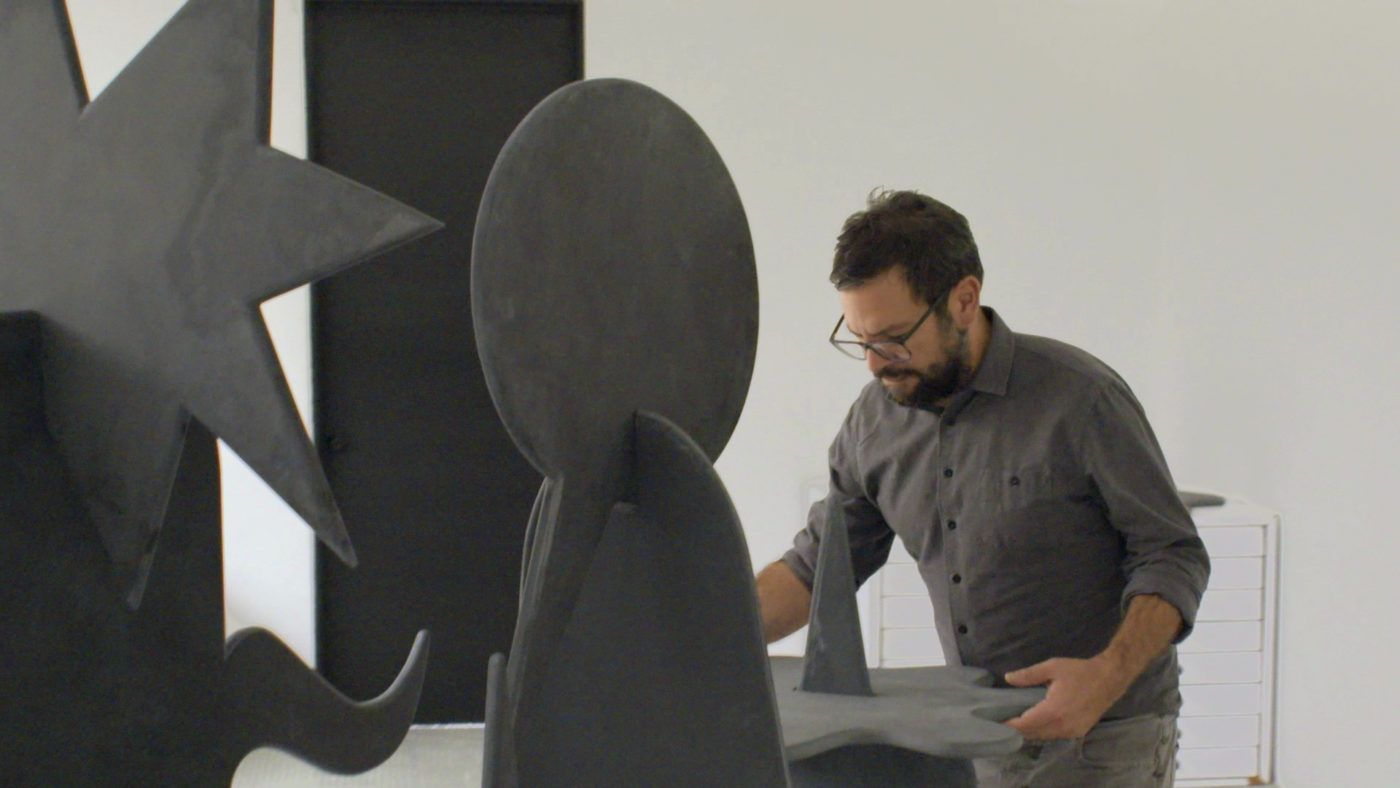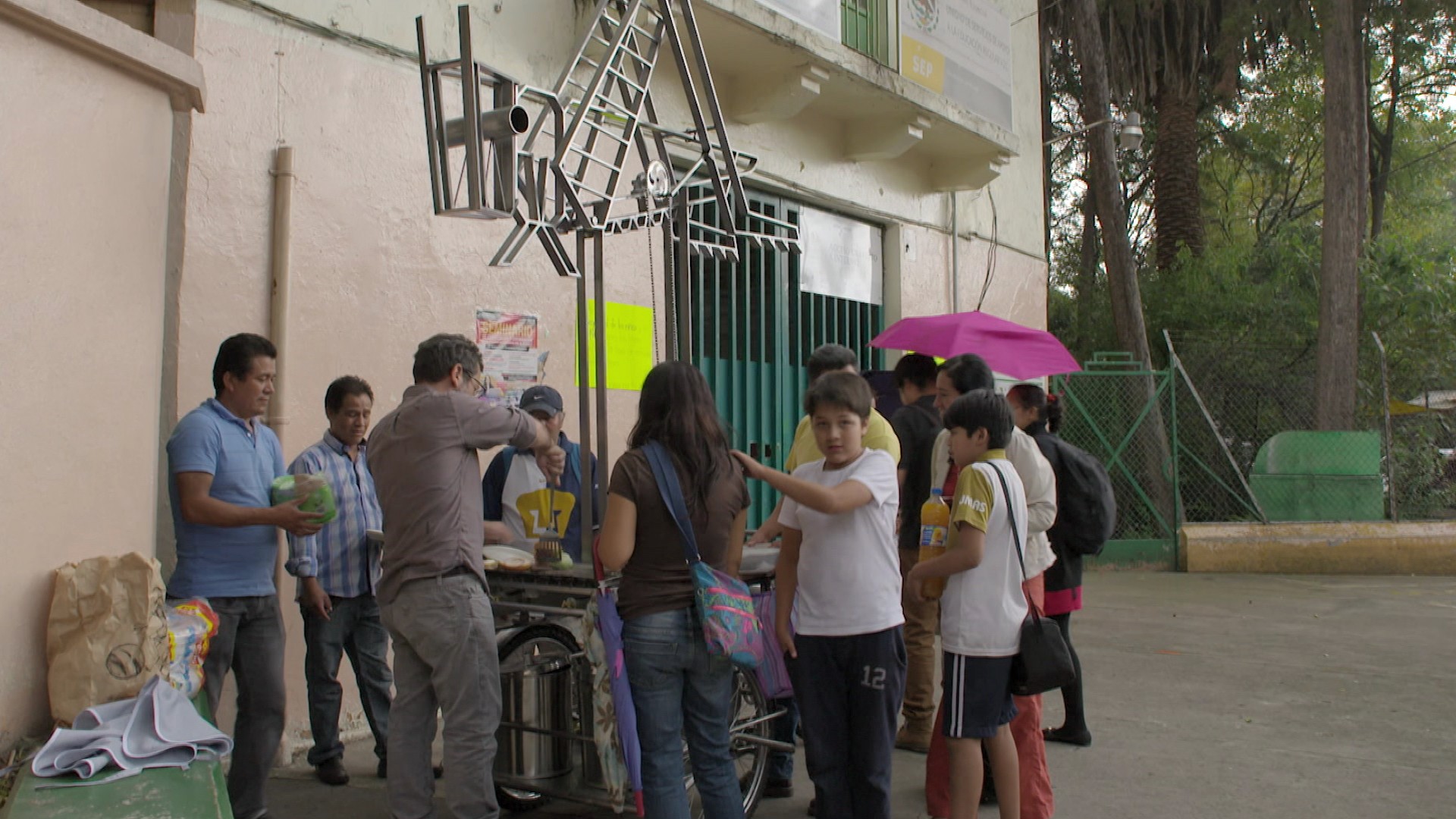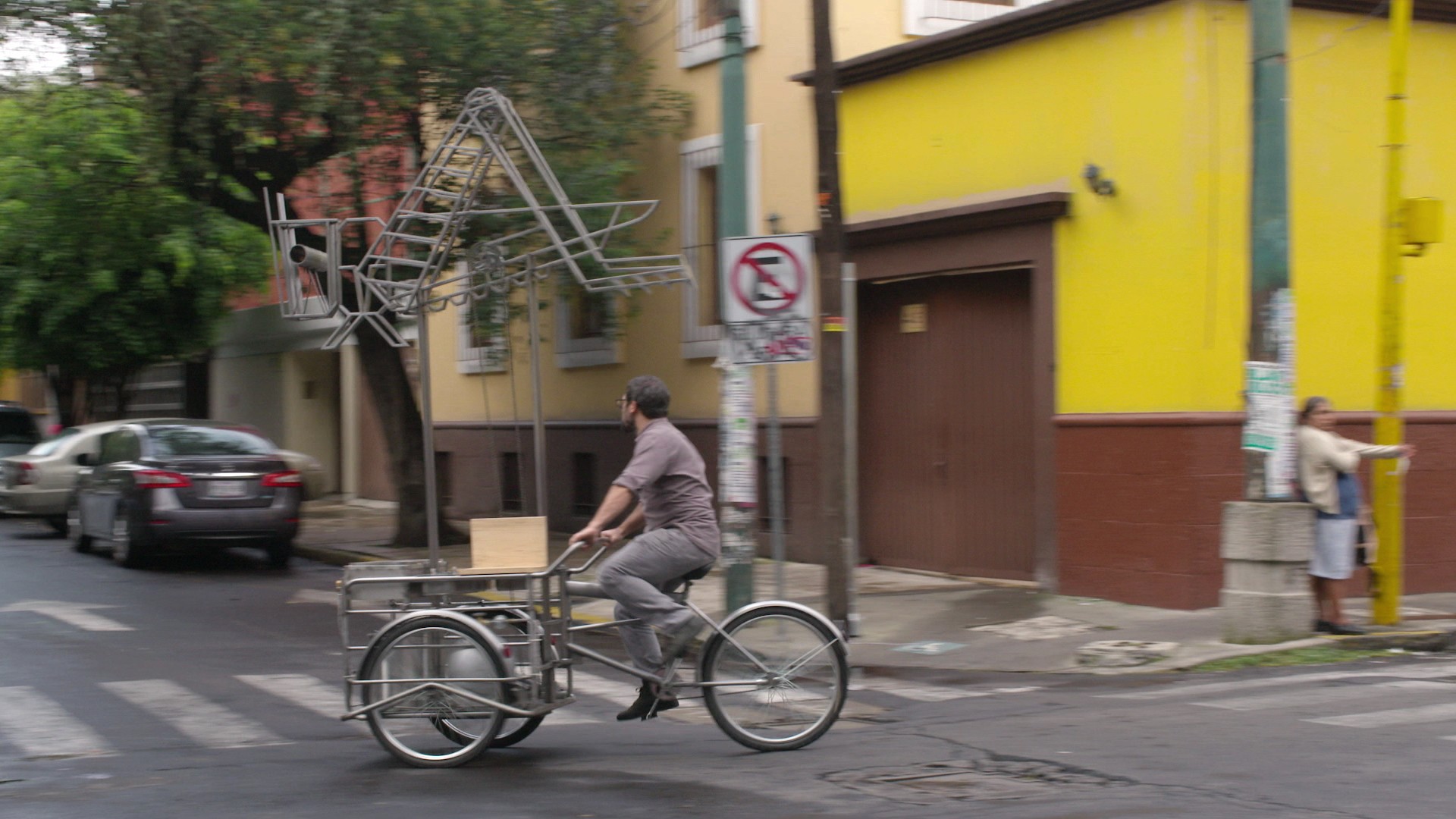Interview
Imagining Alternatives

Pedro Reyes assembles a work in progress, Mexico City, 2015. Production still from the Art in the Twenty-First Century Season 8 episode, "Mexico City," 2016.
Pedro Reyes shares a wide range of influences and discusses his use of play, humor, and optimism to create diverse works that sometimes function as public services.
Art21—Why do you make art?
Pedro Reyes—Art is one of the few cultural environments that allow you freedom; every artist has to come up with a definition of what art is. Art is like many different things. It is a way to interpret the world. It’s also a way to study and understand the world. It also creates opportunity to reinvent things: institutions, relationships, materials, and forms.
I think that everyone can do art, but not everyone is an artist. I differ a little from what Joseph Beuys said, that everybody is an artist. You have to add that everybody can do art, but an artist is someone who has produced art over a certain period. He creates an opus. He creates a take on the world by this accumulative process. It’s not the objects that the artist produces but [rather] the tools and the processes that he uses that contribute to the world a way to handle things.
You consider yourself a sculptor, but when I look at some of your projects, I see a very different idea of what sculpture is. Your work goes beyond sculpture, sometimes into the social realm.
As soon as I feel that I’m being identified with one kind of work, I try to run away from it and open a different line of investigation because I don’t want to be pinpointed or identified with one thing. I want to change medium and subject because I’m very curious, and I get bored easily. I am also very promiscuous in my interests. I always want to explore a new thing.

Pedro Reyes cooks and distributes “Grasswhoppers,” Mexico City, 2015. Production still from the Art in the Twenty-First Century Season 8 episode, Mexico City, 2016.
One of your first projects, Palas por Pistolas, seems to have been the seed for other projects, like Disarm. How did that happen?
Palas por Pistolas is a synthesis of three of my mentors and sources of inspiration: Joseph Beuys, with planting trees [for the work 7000 Oaks]; Antanas Mockus, who had campaigns to collect weapons in Bogotá and turn them into spoons; and an encounter that I had with Alejandro Jodorowsky, in which I asked him about a therapy method he does called psicomagia [psychomagic]. (There’s a ritual to overcome a traumatic situation; it often ends with putting a plant into a pot; he told me that closure has to come with an opening of a new process.) I put together those different ideas from Jodorowsky, Antanas, and Beuys into this one project, Palas por Pistolas, in which the metal from the guns was [melted] but then cast into shovels, to become tools for planting trees.
Often my projects draw inspiration from resources that are not strictly artistic. For instance, Mockus is a politician, Jodorowsky is a filmmaker and therapist, and Beuys was trying to get out and go beyond the sphere of art. I believe the best use of an artist’s time is to find resources beyond art history; otherwise, it can become a very rarified production.
Having your studio at your house must have certain advantages.
My library is one of the main tools I use for working. I think that my library is like my brain. I can get access to all these parts in a very fast way. For instance, there are sections for music, humor, film, theater, philosophy, mythology, mathematics, geometry, neurology, pacifism, poetry, psychology, the social sciences, feminism, social justice, Latin America, military history, and biology. There are sections on fashion, folk art, architecture, industrial design, graphic design, ancient art, contemporary art, eroticism, business, religions, fiction, and so on. Architecture in Mexico is [one of my] big obsessions. My wife and I collect a lot of books on popular arts from Mexico, like craft, photography, textiles, and indigenous culture. There are over eighty-three indigenous groups in Mexico that are very much alive and keep their textiles and festive traditions. [My wife] works directly with them. We both use every section of the library. Going to secondhand bookstores is a way to ensure that I’m not going to run out of ideas. It’s a meditation process, in which I get into a trance and just grab whatever calls my attention. It’s a reservoir of interests that very slowly crystallize into new developments.
You’ve talked about creating a space for violence, that there needs to be a space for it.
I believe that there can be spaces for creative outlets for violence. A lot of artists do this. There have always been elements in theater, in music performance, and in sculpture where artists have space to show their anger and frustration. That makes great art.
Can you describe your project, pUN: People’s United Nations?
In [this alternate] U.N., [a delegate] represents a state. [Delegates] are appointed by their governments and represent their people, but they don’t have to endorse the government or whatever policies are currently in place. That is one difference. The other is to have a very playful approach, using tools from theater, group therapy, pranks, et cetera: conflict-resolution techniques that are more spontaneous and allow collective creativity. [People] stop talking for themselves and start talking with and for a group.
How does role play figure into your work?
Role play is something that I use a lot. I love role play because it allows you to explore parts of yourself that otherwise you couldn’t access easily. For instance, role play is very present in pUN because on a daily basis [each delegate] is in the same room with people from many different countries.
These playful situations allow you to test things. It’s precisely how children play. You create maps by placing objects that are models or representations of the larger world. It’s about how you can provide yourself with an environment where you can discuss things in the effortless spirit of play.
It’s about not being an expert. It’s very important to de-professionalize psychology and politics. It’s killing the expert, in a way; if you always rely on the expert, then you are preventing yourself from having an education and also from having a voice or a position. You have to do it yourself, somehow, and that’s why play is important. I use what Jacob L. Moreno, the inventor of psychodrama, calls surplus reality. Surplus reality is not reality itself, and it’s not fiction. It’s an extra reality, where you can rehearse how you could be. It’s a rehearsal space where you can fail, be wild, be mean, be whatever you want in order to test what consequences would happen without those consequences actually happening; this is your rehearsal. Most of the time, the surplus reality is used to dare to be who you should be or to do what you should do. If you need to have a confrontation with someone, you can test that confrontation in this surplus reality. That’s a beautiful thing because you need spaces where you can prepare for the changes that you will have in real life. That’s another thing that art can do: introduce a strange idea into the world so it becomes accepted.

Pedro Reyes riding his “Grasswhopper” food cart, Mexico City, 2015. still from the Art in the Twenty-First Century Season 8 episode, Mexico City, 2016.
Is humor important, and why?
Humor is an interesting mechanism because the fact that we laugh at something reveals that the subject is uncomfortable and that there’s something problematic or stuck. If we laugh at it, we are somehow dealing with it. What I try to do with some of my workshops is to create punch lines, so that instead of [people] being faced with a traumatic ending, I try to push them to think of largely optimistic scenarios that are so ideal and optimistic that they still make you laugh—“oh, yeah, I wish that would happen.” If you have to craft a joke in which you picture a desirable but extremely optimistic and utopian vision, then you have a certain direction to move in. If you have a desire for a vision, then you can imagine the necessary steps to move in that direction. That’s the theory I have about humor.
Why is optimism so important?
Optimism is extremely important in order to break the cycle of complaint. When you’re complaining, you’re putting blame on someone else, and you’re relieved from responsibility. I believe that’s a very childish position. There is a belief that, through complaining, some change is produced. It’s not. Nothing changes through complaining. I believe that there are too many artists and intellectuals complaining, which certainly can lead to critical mass, but creativity is most needed to imagine alternatives. Describing why things don’t work is different than saying how things can work. When you’re trying to solve problems or heal a disease, you have to be readjusting all the time, and testing something, and doing it again; it’s an active process. I believe that optimism is also a tactical approach that, at least, is trying to come up with solutions. Imagination is extremely important.
That seems to be the role of art.
Yeah, exactly. It’s important to create visions of how would you like things to be, even if they’re naïve. For instance, this piece is extremely naïve: turning a weapon into a musical instrument. I’m fed up with the open-endedness of art, with the idea that if you say something that is straightforward, you’re being messianic or patronizing. I think that what artists do, often, is change the perception of things. At least that’s a hope: that you can make the strange familiar and make the familiar strange.
I studied architecture; I wanted something that was more technical than art although I always wanted to be an artist. In architecture, you learn to solve problems, and you have to answer them through your designs. I think that has stuck with me—the issue of having to solve problems—to such a degree that often it’s hard for me to think about artwork that is just art for art’s sake.

Pedro Reyes prepares materials for “The People’s United Nations (pUN) General Assembly,” a two-day experimental gathering hosted as part of the exhibition “Hammer Projects: Pedro Reyes” at the Hammer Museum, Los Angeles, 2015. Production still from the Art in the Twenty-First Century Season 8 episode, Mexico City, 2016.
You mentioned you wanted to be a mayor. Can you talk about that?
I don’t know if I would love to, but I think that at some point, I would like to be a public servant, to try to produce change at that scale. Right now, I am doing shows, and it’s hard to move away from that. But eventually, who knows?
Why does that appeal to you?
I’m interested in public policy because my hope is that my projects depart from the sphere of the art world and become public programs that could be replicated and continue to happen. I’ve been knocking [on doors] at governmental agencies, trying to get them to adopt these weapon-donation campaigns, in which the weapons are turned into instruments.
Mexico is a context where if you don’t do it, no one else will. Your input is really important. You need to contribute to local development without waiting for authorities or companies to come and do it. I think that’s been very healthy for the scene: everyone has had a space not only for their production but also where they can have other people engage in a dialogue.
Even if your undertaking only touches twenty people, for those who are participating, it is a transformative experience. That is ultimately the test we have to pass; that’s where there is something that stays real.
Most of the work I do, I hope, is such that anyone who experiences it can understand it, regardless of whether they have an art education or know who Duchamp is. I don’t think you need artistic literacy to understand most of the works I do, and I do that on purpose because I believe in art as a communication exercise.
Interview by Deborah Dickson at the artist’s home and studio in Mexico City in August 2015 and January 2016. Originally published in the Art21 publication, Being an Artist.
Editor: Tina Kukielski. Curatorial and Editorial Assistant: Danielle Brock. Copy Editor: Deanna Lee. Published: September 2018. © Art21, Inc.




